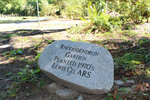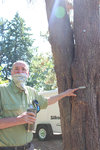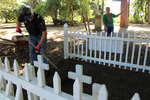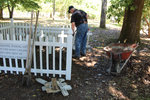



Jan Sparks remembers volunteering in the Fort Borst Park Master Gardener demonstration garden several years ago when someone first mentioned the Fort Borst Park Arboretum to her.
“I said ‘where is it? Where’s the arboretum?’” Sparks said, not knowing at the time she was looking right at the botanical feature. “You couldn’t even tell there was an arboretum here because it was so overgrown.”
Today, Sparks is the president of the newly rejuvenated Borst Park Arboretum Society and aims to uncover the hidden gem that she said so many people are unaware even exists. They are a group of people who come from many walks of life with the one goal of making a space that is welcoming to the community.
“They’re people who just have such a heart for the community,” Sparks said. “We are excited when we see people enjoying the fruits of our labor.”
The Borst Park Arboretum Society has about 14 active members and cares for 18.5 acres that span from the front door of the Borst home carriage house east all the way to the river. The Borst Park Arboretum was originally established in 1960 by forester James Dick, amateur botanist Phil Spicer and Centralia College forestry instructor Rufus Kiser. They organized the planting of 25 trees on the five acres of land next to the current historic Borst home site. The trees came from from around the globe as a test to see what would thrive in the Pacific Northwest. Over the years, more trees were added, and today there are 195 trees in the arboretum, the last of which was planted in 1990.
“They’re from all over the world but mainly the same latitude as the United States,” explained Borst Arboretum Society volunteer Mark Erickson. “I think now about 75 percent of the species are from the Pacific Northwest and the other 25 percent are from other countries.”
In 1970, the Lewis County branch of the American Rhododendron Society also planted about 1,000 rhododendrons in the arboretum. Upkeep of the arboretum was handled by the Borst Park Arboretum Society, which was established in 1961. But over the years, membership in that organization waned. The Lewis County WSU Extension Master Gardener Program helped with the upkeep for a time but found the task too laborious. Six years ago, when Sparks and others, who met as volunteers at the Master Gardener demonstration garden, decided to take on the arboretum’s resurrection, the area had fallen into to serious disrepair. Much of it was overgrown with blackberry bushes, there were many dead and dying trees that needed to be removed and the trees’ canopies were so thick, you could not see between them.
“The homeless were living in here,” Sparks said. “It was something they needed but it meant the community wasn’t using it.”
Worse, Sparks noted, was the loss of the work and pride of those who created the arboretum and surrounding features. For example, she noted that the Borst children’s memorial cemetery had become so overgrown that you could only read two of the five names on the small, wooden crosses. Recently, volunteers also uncovered both a stone marker near the dog park dedicating the planting of the rhododendrons as well as a memorial plaque for Spicer in a grove of rhododendrons near the Borst home.
“That one broke our hearts when we saw it, to see that it wasn’t kept up,” Sparks said of the plaque for Spicer.
With help from City of Centralia Community Development Director Emil Pierson, the Borst Arboretum Society has been able to make strides in uncovering more and more of this historical gem in Centralia. Volunteers have brought up the tree canopies, trimmed rhododendrons and cleared many paths that had previously been nearly impassable.
“We’re trying to open up more tails to bring more people in from other areas,” Sparks said. “We want people to be able to use it year-round.”
This year, many group activities have been closed due to social distancing restrictions due to COVID-19 but the Borst Park Arboretum Society has been able to keep up with its work. Earlier in the year, Sparks attended COVID-19 training through the City of Centralia so that she could understand the regulations the group must follow to continue to gather. They hold weekly work parties, where volunteers don their masks and get to work. This year, they have: expanded trails and plan to add trail markers soon; brought in picnic tables; and have been working on adding identifying numbers and labels to every tree in the arboretum.
The Borst Park Arboretum Society is in the application process to receive 501(c)(3) non-profit status, since all of its work is supported by donations. Eventually, society members would like to be able to add more specimens to the arboretum. But Sparks said the biggest obstacle to that goal is finding a way to get water to them. When the arboretum was originally platted, a number of local garden clubs raised money to install an in-ground watering system, complete with pump houses that are still there today. However, because the system is fed from the river, it can no longer be used. Sparks said a few of the existing trees and rhododendrons have had to be removed because they were dead or dying from lack of water. One of their biggest wish list items, besides more volunteers, is a way to reliably water the arboretum.
On a recent Sunday afternoon, a couple driving through from Seattle stopped for a picnic under the trees and local moms walked dogs and kids through the trails. They’ve seen senior pictures and wedding portraits taken under the canopy and they’ve seen little leaguers and soccer families enjoy breaks in tournaments among the trees. Society member Lynn Ford said they all enjoy seeing the community enjoy the space as well as the knowledge they are honoring the legacy of those who created the arboretum.
“We just want the community to enjoy the area for what it was intended for,” Ford said.